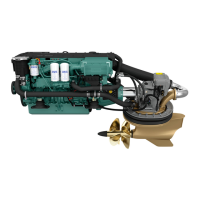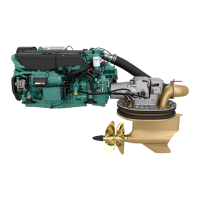Do you have a question about the Volvo Penta IPS 600 and is the answer not in the manual?
General introduction to safety information presented in the manual and on the engine.
Details safety measures to follow while operating the boat, including refueling and maneuvering.
Covers safety measures during maintenance and service work on the engine and boat systems.
Volvo Penta's commitment to environmental responsibility and user guidance on eco-friendly operation.
Instructions for the initial break-in period of the engine to ensure optimal performance and longevity.
Guidelines on using recommended fuels and oils to prevent operating problems and ensure engine longevity.
Special requirements for maintenance and service of exhaust emission certified engines.
Details on the limited warranty coverage for Volvo Penta marine engines and how to maintain its validity.
Highlights the key features and benefits of the Volvo Penta IPS system for improved efficiency and comfort.
Explains the steering system and joystick controls for exceptional maneuverability and ease of handling.
Provides a detailed breakdown of the D6 engine's technical specifications and components.
Describes the Electronic Vessel Control (EVC) system, its distributed architecture, and key functions.
Illustrates the engine and drive-unit with labels identifying key components for easy reference.
Describes standard engine instruments like tachometer, voltmeter, oil pressure, and temperature gauges.
Explains the function of the ignition lock and the start/stop panel for engine operation.
Details the function of various warning lamps and their indications for engine status.
Guides users on operating the EVC control panel buttons for navigation and settings.
Explains how to navigate menus, view trip information, gauges, and settings on the EVC tachometer.
Describes the LCD display functions for operating information, configuration, and system status.
Details the operation of the electronic control lever for shifting and engine speed adjustment.
Explains how to adjust the friction brake on the control lever for desired resistance.
Essential visual checks and tasks to perform before starting the engine for safe operation.
Step-by-step guide on how to start the engine using the ignition key or starter button.
How to interpret readings from various engine instruments during operation.
Procedure for acknowledging alarms and responding to system messages displayed on the tachometer.
Recommendations for achieving best fuel economy and performance by maintaining optimal cruising speeds.
Benefits and procedure for synchronizing twin engines for improved comfort and economy.
Detailed instructions on using the joystick for precise boat maneuvering during docking.
Correct procedure for stopping the engine to prevent damage and ensure proper shutdown.
Measures to prevent freezing damage to the cooling and seawater systems in cold conditions.
Specific steps for preparing the boat and drive-unit for storage on land.
Routine checks to be performed daily before the first engine start for safety and proper function.
Maintenance tasks to be performed every 14 days, including belt and battery checks.
Recommended maintenance for intervals of 100-200 hours or annually, including filter changes.
Visual inspection of the engine and engine room for leaks, wear, and loose connections.
How to check belt tension and condition, and procedures for adjustment and replacement.
Guidance on checking oil levels, changing engine oil, and replacing oil filters.
Procedures for checking coolant levels and draining the freshwater cooling system.
Instructions for cleaning and changing the seawater filter and impeller.
Steps for changing the fuel filter and bleeding the fuel system.
Safety precautions and procedures for maintaining the boat's electrical system and batteries.
Procedure for checking and topping up the drive-unit oil level, ensuring proper lubrication.
Steps for draining the drive-unit oil, replacing the filter, and refilling with new oil.
Guidance on inspecting and replacing sacrificial anodes to prevent galvanic corrosion.
Step-by-step instructions for removing propellers from the drive-unit shaft.
Procedures for installing propellers, including tightening nuts and locking rings to specifications.
Steps for inhibiting the engine and systems to protect against corrosion during storage.
Checks and procedures required to prepare the boat and engine after storage before launching.
Instructions for maintaining hull antifouling coating and painting the underwater hull.
Safe steps for jump-starting the engine using auxiliary batteries.
Manual method to engage forward gear if the drive-unit cannot be shifted with the control lever.
Manual procedure to align the drive-unit to the straight-forward position.
Table correlating engine symptoms with possible causes and recommended actions.
Explains how the diagnostic system monitors, detects, and reports malfunctions.
How to view, acknowledge, and manage fault codes in the EVC system.
Explains faults related to engine speed, fuel system water presence, and seawater pressure.
Covers faults related to air, coolant, and oil temperatures and pressures.
Details faults related to engine oil level, pressure, temperature, and filter condition.
Addresses faults related to battery voltage, supply fuses, and auxiliary stop signals.
Explains faults concerning control lever, lever calibration, and the EVC system itself.
Covers faults related to the steering system, joystick, and engine RPM limits.
Provides general technical data for the engine, including speeds, volumes, and inclinations.
Details technical specifications for the drive-unit, including oil volumes, grades, and gear ratios.
General introduction to safety information presented in the manual and on the engine.
Details safety measures to follow while operating the boat, including refueling and maneuvering.
Covers safety measures during maintenance and service work on the engine and boat systems.
Volvo Penta's commitment to environmental responsibility and user guidance on eco-friendly operation.
Instructions for the initial break-in period of the engine to ensure optimal performance and longevity.
Guidelines on using recommended fuels and oils to prevent operating problems and ensure engine longevity.
Special requirements for maintenance and service of exhaust emission certified engines.
Details on the limited warranty coverage for Volvo Penta marine engines and how to maintain its validity.
Highlights the key features and benefits of the Volvo Penta IPS system for improved efficiency and comfort.
Explains the steering system and joystick controls for exceptional maneuverability and ease of handling.
Provides a detailed breakdown of the D6 engine's technical specifications and components.
Describes the Electronic Vessel Control (EVC) system, its distributed architecture, and key functions.
Illustrates the engine and drive-unit with labels identifying key components for easy reference.
Describes standard engine instruments like tachometer, voltmeter, oil pressure, and temperature gauges.
Explains the function of the ignition lock and the start/stop panel for engine operation.
Details the function of various warning lamps and their indications for engine status.
Guides users on operating the EVC control panel buttons for navigation and settings.
Explains how to navigate menus, view trip information, gauges, and settings on the EVC tachometer.
Describes the LCD display functions for operating information, configuration, and system status.
Details the operation of the electronic control lever for shifting and engine speed adjustment.
Explains how to adjust the friction brake on the control lever for desired resistance.
Essential visual checks and tasks to perform before starting the engine for safe operation.
Step-by-step guide on how to start the engine using the ignition key or starter button.
How to interpret readings from various engine instruments during operation.
Procedure for acknowledging alarms and responding to system messages displayed on the tachometer.
Recommendations for achieving best fuel economy and performance by maintaining optimal cruising speeds.
Benefits and procedure for synchronizing twin engines for improved comfort and economy.
Detailed instructions on using the joystick for precise boat maneuvering during docking.
Correct procedure for stopping the engine to prevent damage and ensure proper shutdown.
Measures to prevent freezing damage to the cooling and seawater systems in cold conditions.
Specific steps for preparing the boat and drive-unit for storage on land.
Routine checks to be performed daily before the first engine start for safety and proper function.
Maintenance tasks to be performed every 14 days, including belt and battery checks.
Recommended maintenance for intervals of 100-200 hours or annually, including filter changes.
Visual inspection of the engine and engine room for leaks, wear, and loose connections.
How to check belt tension and condition, and procedures for adjustment and replacement.
Guidance on checking oil levels, changing engine oil, and replacing oil filters.
Procedures for checking coolant levels and draining the freshwater cooling system.
Instructions for cleaning and changing the seawater filter and impeller.
Steps for changing the fuel filter and bleeding the fuel system.
Safety precautions and procedures for maintaining the boat's electrical system and batteries.
Procedure for checking and topping up the drive-unit oil level, ensuring proper lubrication.
Steps for draining the drive-unit oil, replacing the filter, and refilling with new oil.
Guidance on inspecting and replacing sacrificial anodes to prevent galvanic corrosion.
Step-by-step instructions for removing propellers from the drive-unit shaft.
Procedures for installing propellers, including tightening nuts and locking rings to specifications.
Steps for inhibiting the engine and systems to protect against corrosion during storage.
Checks and procedures required to prepare the boat and engine after storage before launching.
Instructions for maintaining hull antifouling coating and painting the underwater hull.
Safe steps for jump-starting the engine using auxiliary batteries.
Manual method to engage forward gear if the drive-unit cannot be shifted with the control lever.
Manual procedure to align the drive-unit to the straight-forward position.
Table correlating engine symptoms with possible causes and recommended actions.
Explains how the diagnostic system monitors, detects, and reports malfunctions.
How to view, acknowledge, and manage fault codes in the EVC system.
Explains faults related to engine speed, fuel system water presence, and seawater pressure.
Covers faults related to air, coolant, and oil temperatures and pressures.
Details faults related to engine oil level, pressure, temperature, and filter condition.
Addresses faults related to battery voltage, supply fuses, and auxiliary stop signals.
Explains faults concerning control lever, lever calibration, and the EVC system itself.
Covers faults related to the steering system, joystick, and engine RPM limits.
Provides general technical data for the engine, including speeds, volumes, and inclinations.
Details technical specifications for the drive-unit, including oil volumes, grades, and gear ratios.
| Displacement | 5.5 L |
|---|---|
| Number of Cylinders | 6 |
| Fuel System | Common Rail |
| Configuration | In-line |
| Rated Speed | 3500 rpm |
| Cooling System | Freshwater cooled |
| Engine Type | Diesel |
| Torque | 1050 Nm |
| Emissions Compliance | EPA Tier 3 |











